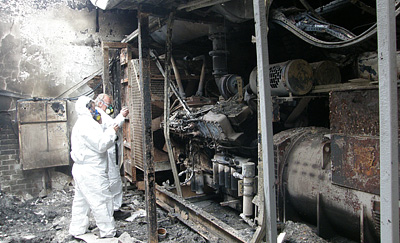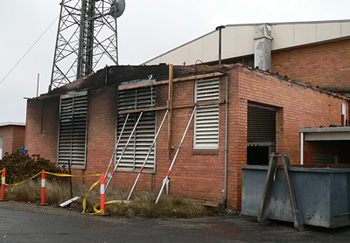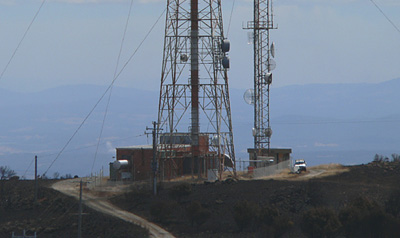A Network Under Fire
Australia’s climate has always been one of extremes. This was demonstrated to a large extent earlier this year when the country was subjected to a succession of heatwaves, bushfires, floods and storms. The impact of these weather variations was massive. The tragic loss of life and damage to homes and infrastructure underlined the destructive power of such events.
Broadcast Australia’s countrywide broadcast network did not escape unscathed. With fires and floods sweeping through a number of transmission sites, and cyclones battering antenna arrays, Broadcast Australia’s Network Operations Centre (NOC) - a central point from which its transmission sites are remotely monitored and managed - had its work cut out for it.
With a communications connection to transmission sites, the NOC constantly monitors the status of all sites and services in the Broadcast Australia network. This ability to remotely operate and manage transmission sites is key to keeping broadcast services on-air on a day-to-day basis. When the network came ‘under attack’, the NOC played a critical role in Broadcast Australia’s emergency response plan, and enabled damaged infrastructure to be brought back online quickly.
In an emergency situation, such as a fire, flood or storm, it is essential that broadcast infrastructure and broadcasters’ services are safeguarded, or brought back online as soon as possible. Here, well-established emergency-response procedures play a crucial role. Furthermore, having access to a comprehensive suite of information, such as network diagnostics and operational data - obtained from the NOC - simplifies the implementation of these procedures and allows informed decisions to be made.

The remains of a diesel generator at the Mt Tassie site While the NOC oversees critical parameters associated with each service and transmission site in the network, it is also responsible for monitoring weather conditions via the Bureau of Meteorology and Country Fire Authority (CFA).
Much of this information is leveraged to safeguard broadcast infrastructure prior to a natural disaster taking place. From the NOC, operation of standby generators can be monitored, standby equipment status assessed and network system checks executed. When safe, site teams are deployed to perform any required manual safeguarding tasks, such as physically securing equipment or performing manual shutdowns.
If a fire, flood or storm hits and broadcast services are lost, a ‘Crisis Management Plan’ is executed. Headed up by the NOC Operations Manager, the Crisis Management Team works with other technical specialists, local authorities, broadcasters and other relevant stakeholders to ensure that services are restored as soon as possible. Furthermore, a dedicated help desk is set up at the NOC to coordinate restoration activities and field incoming inquiries.
The importance of such well-established emergency response strategies was illustrated during the recent Victorian bushfires that ravaged the southern Australian state. With transmission sites located at Mount Tassie and Marysville in southern Victoria sustaining significant damage, broadcast services in the area were lost.
The Mount Tassie site provides direct broadcasting and communications services to the nearby Latrobe Valley, while also delivering programme feeds to seven other retransmission sites in the vicinity.
After receiving a number of automated equipment alarms back at the NOC, there was a controlled shutdown of some of the site’s equipment in an attempt to safeguard it from the approaching flames. The fire engulfed the transmission site’s generator room and office, damaging the mains power supply, back-up generator, battery banks and control systems.
Once the fires had passed, leaving the transmission site offline, Broadcast Australia’s Crisis Management Team swung into action to restore transmissions.
When safe, a team of broadcast transmission technicians was deployed to the site to assess the damage sustained by the Mount Tassie transmission facility. A site disaster coordinator was appointed to manage all local issues and a field services coordinator to coordinate repairs and site activities - both reported to the operations manager back at the NOC.
In the following days, the site restoration team worked around-the-clock to install and configure temporary power supply and other site infrastructure, to get the first service back on air less than 48 hours after the disaster. Remaining services were gradually restored in the following two weeks.
Temporary transmissions
The immediate restoration of broadcast services - especially local radio - to the local area is a high priority of the site restoration team. In such disaster situations, it is often local radio that provides important information to the public and support services. As a result, the restoration of these broadcast services often takes precedence. Here, portable temporary transmission facilities play a significant role.

The charred exterior of the Mt Tassie site’s generator room Deployed to nearby safe areas after fire, floods and storms, these portable temporary transmission facilities permit the receiving and retransmitting of services from nearby sites, or act as an all-in-one self-contained mini studio with on-board transmitter to provide entirely new broadcast services.
Frequency agile emergency broadcast systems (fly-away kits) were utilised extensively after Victoria’s recent bushfires, as well as floods in Ingham, Queensland, and Pannawonica, Western Australia.
Interestingly, the fires that swept through the Mount Tassie site had repercussions extending beyond the damage to the broadcast infrastructure itself, affecting a number of retransmission sites in eastern Victoria, which obtain their programme input from Mount Tassie. As a result of the damage to Mount Tassie, these re-transmission facilities were left without a transmission feed, and the areas they support left without broadcast services.
While restoration works continued at Mount Tassie, these retransmission sites were reconfigured to receive transmission feeds from alternative input sources. Some of this reconfiguring was performed remotely from the NOC, while many of the adaptations, such as re-panning receive antennas, or installing satellite receive equipment, were performed on site. Again, Broadcast Australia deployed a series of site technician teams to make the necessary modifications.
While there isn’t a lot that can be done to physically safeguard broadcast infrastructure from a rampaging bushfire or rising floodwaters, there are measures that can be taken to provide broadcasters with a greater chance of keeping services online following a disaster - particularly if the site only sustains partial damages.

The blackened earth surrounds the Mt Tassie site following the destructive bushfires. Broadcast Australia’s countrywide broadcast network has been designed with layers of built-in redundancy. A number of sites are equipped with duplicated equipment and antenna systems, such as automatic ‘fail-over’, or ‘n+1’ systems. Depending on the role of the site in the network, switching to standby equipment is achieved manually or automatically, locally or remotely from the NOC.
Furthermore, some antenna systems have been designed to allow switching between the top or bottom half of the antenna. This permits continuous operation - albeit at reduced power- even if part of the antenna system is damaged. It also allows transmissions to continue during regular maintenance and troubleshooting.
On some sites, high levels of redundancy have been integrated into the programme input equipment with measures in place to receive transmissions from an alternate source, such as landline, satellite and off-air. Many sites are also equipped with back-up diesel generators in the event that mains power is lost.
For any given transmission site in Broadcast Australia’s network, the NOC will monitor several critical parameters associated with each service and the site as a whole. These include the input feed and equipment (such as satellite/microwave link or off-air receiver/repeater), transmitters and associated ancillary equipment (such as modulators and exciters), antenna systems, environmental control equipment (such as air-conditioning) and power. With around 50 percent of faults swiftly and easily rectified by a remote reset of equipment from the NOC, it means mobilisation of field maintenance technicians can often be avoided, and the service restored within minutes of the remote diagnosis. Luckily, these days, most terrestrial broadcast transmission sites across the world are unmanned, so in the event of a natural disaster, the direct threat to human life is minimised.
However, the loss or damage to broadcast infrastructure still has the potential to significantly impact the safety of the wider community. Evacuees, support services and local authorities are reliant on broadcast communications (in the affected area and those areas supported by retransmission sites). It is, therefore, important that broadcast infrastructure providers implement resilient network designs and formulate well-drilled emergency response plans, to minimise the immediate and long-term impact of natural disasters on broadcast services.
Clive Morton is Broadcast Australia’s engineering and field services director.
The professional video industry's #1 source for news, trends and product and tech information. Sign up below.
